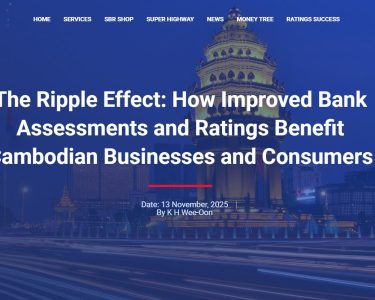If money is the lifeblood of an economy, banks are its heart and arteries—channeling funds from savers to borrowers to keep businesses and households running. But what happens when some of that money is not paid back?
In Cambodia, rising repayment failures are beginning to weigh on banks’ balance sheets and profitability, much like blockages slowing the flow of blood through the body. If left unaddressed, this could undermine the soundness of the banking system and, in turn, macroeconomic stability. A recent AMRO analysis examined why rising “bad loans” matter and how solutions such as a “bad bank” could help turn this challenge into an opportunity.
NPLs at a record high
Cambodia’s banks are grappling with a growing problem: non-performing loans (NPLs), or loans that borrowers fail to repay on time. By June 2025, NPLs had reached KHR 19.0 trillion (around USD 4.7 billion), making up 8.1 percent of total loans—the highest in years (Figure 1), driven by the delayed recognition of distressed loans during the pandemic, and slowing credit growth amid more cautious lending attitude and subdued demand.

When loans go unpaid, banks risk losing the funds they have lent. On a large scale, this can erode liquidity and capital buffers. Under stress, banks typically tighten lending standards, while subdued borrower demand amid heightened global uncertainty further dampens credit growth (Figure 2). The result is an economy where financial circulation is slowing—much like a body struggling with poor blood flow.
To buy time, the National Bank of Cambodia (NBC) re-launched a loan forbearance program in 2024, allowing banks to restructure bad loans up to twice without extra penalties. While forbearance offers temporary relief, it may also mask deeper solvency issues for borrowers who ultimately cannot repay. With the program set to phase out gradually, Cambodia needs a longer-term, structural solution.
Cleaning up with an Asset Management Company
One option under consideration is the establishment of an Asset Management Company (AMC)—often called a “bad bank” or a “financial janitor.” Its role is to acquire bad loans from banks and work them out, freeing banks to focus on healthy lending.
This approach has proven effective elsewhere. For example, after the Asian Financial Crisis, Indonesia, Malaysia, Korea, and Thailand all established AMCs that successfully reduced their banks’ NPL ratios (Table 1; Figure 3).

At present, Cambodian banks have limited institutional capacity and experience in handling surging bad loans. Due to legal and regulatory gaps, they mainly rely on basic tools such as loan restructuring, write-offs, and direct debt collection. These measures can be slow and, in some cases, vulnerable to fraud or misuse.
An AMC could offer a more efficient solution–purchasing NPLs directly from banks, enabling faster balance sheet cleanup, and consolidating specialized expertise in asset recovery and restructuring. This would not only support renewed lending and growth but also help build a more robust financial system.
Designing it right
But an AMC is no panacea. Poorly designed models can induce moral hazard and become dumping grounds for bad loans, drain public funds, or even encourage reckless lending. To avoid such pitfalls, Cambodia would need a thorough pre-establishment assessment and a clear, well-crafted mandate.
A centralized AMC model—supported by both public and private funding—could be tailored to Cambodia’s needs. Key success factors would include prudent asset selection, sound valuation methods, robust governance frameworks, and competent staff that ensure independence, transparency, accountability, and efficiency. Close coordination between the public and private sectors will also be essential to build institutional capacity and ensure smooth implementation.
Today, bad loans may be a persistent headache for Cambodia’s banks. But with the right treatment, this challenge can become a catalyst for progress. A well-designed AMC could help modernize Cambodia’s financial architecture, strengthen its crisis-management frameworks, and enhance financial resilience in the years ahead.
Disclaimer: AMRO Blog is a forum for the views of AMRO staff and officials on pressing economic and policy issues. The views expressed are those of the author(s) and do not necessarily represent the views of AMRO and its Executive Committee. You are welcome to republish AMRO Blog post but please attribute the piece to the author(s), and note that it was first published as AMRO Blog, with a link to our blog.





